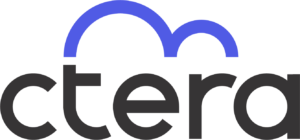Table of Contents
- Summary
- Key Criteria Analysis
- Evaluation Metrics Analysis
- Bottom Line
- About GigaOm
- Copyright
1. Summary
CTERA has created a compelling solution that enables organizations of all sizes to build next-generation file-service infrastructures that can replace traditional network attached storage environments, while also providing additional seamless access methods for users and applications located at the edge or in the public cloud. From the user perspective, the file services look like a traditional shared volume on the network, but data is actually stored in public clouds or on on-premises object stores and cached locally for speed of access. Data can be accessed through virtual or physical edge appliances or software clients installed on remote devices, making the solution really flexible and user-friendly. Furthermore, the CTERA Portal aggregates all back-end access, security, and management functions to give a comprehensive view to system administrators and the necessary scalability to the entire infrastructure.
By replacing not only the shared storage component but also the related data protection infrastructure, network optimization, and VPN tools, while also centralizing system management and using a less-expensive storage back end, CTERA provides important savings in terms of overall TCO even as it simplifies the path to adopt hybrid and multi-cloud storage.
CTERA’s attention to multi-tenancy and security issues drove its success in large enterprises, regulated industries, and public administrations. At the same time, CTERA’s platform can start with a minimal configuration that is appealing to medium-sized organizations, and smaller ones can take advantage of the product in a SaaS fashion through many service providers across the globe that adopted the solution for their customers. Subscription-based licensing tied to the number of users and the ability to run the edge appliance on bare metal hardware as well as virtual machines increase the options for customers and the flexibility of the solution.
This solution is not designed to replace the high-performance file systems normally adopted for HPC, AI, or big data applications. What it offers is the ability to create a single global namespace on a scalable file system associated with all-flash edge appliances and several performance optimizations, enabling users to deploy the solution in high-demand environments as well.
How to Read this Report
This GigaOm report is one of a series of documents that helps IT organizations assess competing solutions in the context of well-defined features and criteria. For a fuller understanding consider reviewing the following reports:
Key Criteria report: A detailed market sector analysis that assesses the impact that key product features and criteria have on top-line solution characteristics—such as scalability, performance, and TCO—that drive purchase decisions.
GigaOm Radar report: A forward-looking analysis that plots the relative value and progression of vendor solutions along multiple axes based on strategy and execution. The Radar report includes a breakdown of each vendor’s offering in the sector.
Solution Profile: An in-depth vendor analysis that builds on the framework developed in the Key Criteria and Radar reports to assess a company’s engagement within a technology sector. This analysis includes forward-looking guidance around both strategy and product.
